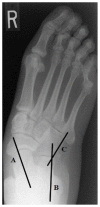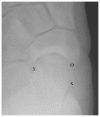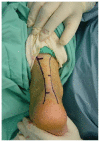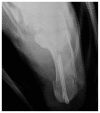A pictorial review of reconstructive foot and ankle surgery: evaluation and intervention of the flatfoot deformity
- PMID: 29299095
- PMCID: PMC5743145
- DOI: 10.3941/jrcr.v11i6.2757
A pictorial review of reconstructive foot and ankle surgery: evaluation and intervention of the flatfoot deformity
Abstract
This pictorial review focuses on basic procedures performed within the field of podiatric surgery, specifically for elective reconstruction of the midfoot and rearfoot with focus on the flatfoot deformity. Our goal is to demonstrate objective radiographic parameters that surgeons utilize to initially define the deformity, lead to procedure selection, and judge post-operative outcomes. We hope that radiologists will employ this information to improve their assessment of post-operative radiographs following reconstructive foot surgeries. First, relevant radiographic measurements are defined and their role in procedure selection explained. Second, the specific surgical procedures of the Evans calcaneal osteotomy, medial calcaneal slide osteotomy, Cotton osteotomy, subtalar joint arthroeresis, and arthrodeses of the rearfoot are described. Finally, specific plain film radiographic findings that judge post-operative outcomes for each procedure are detailed.
Keywords: Calcaneal Osteotomy; Coalition; Cotton osteotomy; Flatfoot; Podiatric surgery.
Figures

















Similar articles
-
A pictorial review of reconstructive foot and ankle surgery: elective lesser forefoot procedures.J Radiol Case Rep. 2016 Nov 30;10(11):8-22. doi: 10.3941/jrcr.v10i11.2458. eCollection 2016 Nov. J Radiol Case Rep. 2016. PMID: 28580056 Free PMC article. Review.
-
A pictorial review of reconstructive foot and ankle surgery: hallux abductovalgus.J Radiol Case Rep. 2015 Jun 30;9(6):29-43. doi: 10.3941/jrcr.v9i6.2142. eCollection 2015 Jun. J Radiol Case Rep. 2015. PMID: 26622935 Free PMC article.
-
Operative treatment of the difficult stage 2 adult acquired flatfoot deformity.Foot Ankle Clin. 2001 Mar;6(1):95-119. doi: 10.1016/s1083-7515(03)00083-4. Foot Ankle Clin. 2001. PMID: 11385931 Review.
-
Cotton Osteotomy in Flatfoot Reconstruction: A Review of Consecutive Cases.J Foot Ankle Surg. 2017 Sep-Oct;56(5):990-995. doi: 10.1053/j.jfas.2017.04.007. Epub 2017 Jul 6. J Foot Ankle Surg. 2017. PMID: 28688712
-
Radiographic Correction Following Reconstruction of Adult Acquired Flat Foot Deformity Using the Cotton Medial Cuneiform Osteotomy.Foot Ankle Int. 2016 May;37(5):508-13. doi: 10.1177/1071100715620894. Epub 2015 Dec 14. Foot Ankle Int. 2016. PMID: 26666677 Clinical Trial.
Cited by
-
Sonographic and radiographic findings of posterior tibial tendon dysfunction: a practical step forward.Skeletal Radiol. 2019 Jan;48(1):11-27. doi: 10.1007/s00256-018-2976-7. Epub 2018 May 25. Skeletal Radiol. 2019. PMID: 29802532 Review.
-
Management of pediatric foot deformities: an imaging review.Pediatr Radiol. 2019 Nov;49(12):1678-1690. doi: 10.1007/s00247-019-04503-4. Epub 2019 Nov 4. Pediatr Radiol. 2019. PMID: 31686173 Review.
-
Osteotomies: Indications, Imaging Appearance, Surgical Techniques, and Complications.Diagnostics (Basel). 2025 May 8;15(10):1184. doi: 10.3390/diagnostics15101184. Diagnostics (Basel). 2025. PMID: 40428177 Free PMC article. Review.
-
Clinical and radiological outcomes of Evan's osteotomy in young patients with flexible flatfoot deformity: a retrospective investigation.BMC Musculoskelet Disord. 2025 Aug 7;26(1):755. doi: 10.1186/s12891-025-08978-1. BMC Musculoskelet Disord. 2025. PMID: 40775712 Free PMC article.
-
Radiographic Measurements of the Foot and Ankle After Ankle Arthrodesis.Foot Ankle Orthop. 2023 Jul 24;8(3):24730114231187888. doi: 10.1177/24730114231187888. eCollection 2023 Jul. Foot Ankle Orthop. 2023. PMID: 37502710 Free PMC article.
References
-
- Mahan KT, Flanigan KP. Pes plano valgus deformity. In: Banks AS, Downey MS, Martin DE, Miller SJ, editors. McGlamry’s Comprehensive Textbook of Foot and Ankle Surgery. Third edition. Philadelphia: Lippincott, Williams and Wilkins; 2001. pp. 799–861. ASIN: B008GE9GEI.
-
- Dimmick S, Chhabra A, Grujic L, Linklater JM. Acquired flat foot deformity: Postoperative imaging. Semin Musculoskelet Radiol. 2012;16:217–232. - PubMed
-
- Sanner WH. Foot segmental relationships and bone morphology. In: Christman RA, editor. Foot and Ankle Radiology. First edition. ISBN-13. St Louis: Churchill Livingstone; 2003. pp. 272–302.pp. 978–0443087820.
-
- Meyr AJ, Wagoner MR. Descriptive quantitative analysis of rearfoot alignment radiographic parameters. J Foot Ankle Surg. 2015;54(5):860–71. - PubMed
-
- Williamson ERC, Chan JY, Burket JC, Deland JT, Ellis SJ. New radiographic parameter assessing hindfoot alignment in stage II adult-acquired flatfoot deformity. Foot Ankle Int. 2014;36(4):417–423. - PubMed
Publication types
MeSH terms
LinkOut - more resources
Full Text Sources
Other Literature Sources
Medical

